Chopta Chandrashila Trek From Delhi : Chopta tour package searches spike during the monsoon for good reason—this serene Himalayan destination offers a rare blend of adventure, tranquility, and spiritual energy, especially in the rainy season. As clouds float over emerald meadows and the scent of pine fills the cool, moist air, Choptain monsoon becomes a paradise for nature lovers and trekkers alike.
With fewer crowds and mist-covered trails, the Chopta Tungnath Trek takes on a mystical charm. Rain-kissed forests, gently flowing streams, and hidden wildlife sightings turn an already scenic route into an unforgettable experience. And at 3,680 meters, the Tungnath Temple the highest Shiva temple in the world—offers a peaceful, fog-draped spiritual encounter far from the usual hustle of tourist seasons.
Still, monsoon trekking comes with its own challenges. Wet trails, unpredictable weather, and reduced visibility require extra caution. But with the right mindset, preparation, and a Chopta tour package tailored for the season, the rewards far outweigh the risks.
This blog will guide you through essential monsoon trekking tips to keep you safe, dry, and energized—from detailed trail overviews to packing checklists and spiritual detours. If you’re ready to experience the Himalayas at their most vibrant and soulful, Chopta in monsoon is calling.
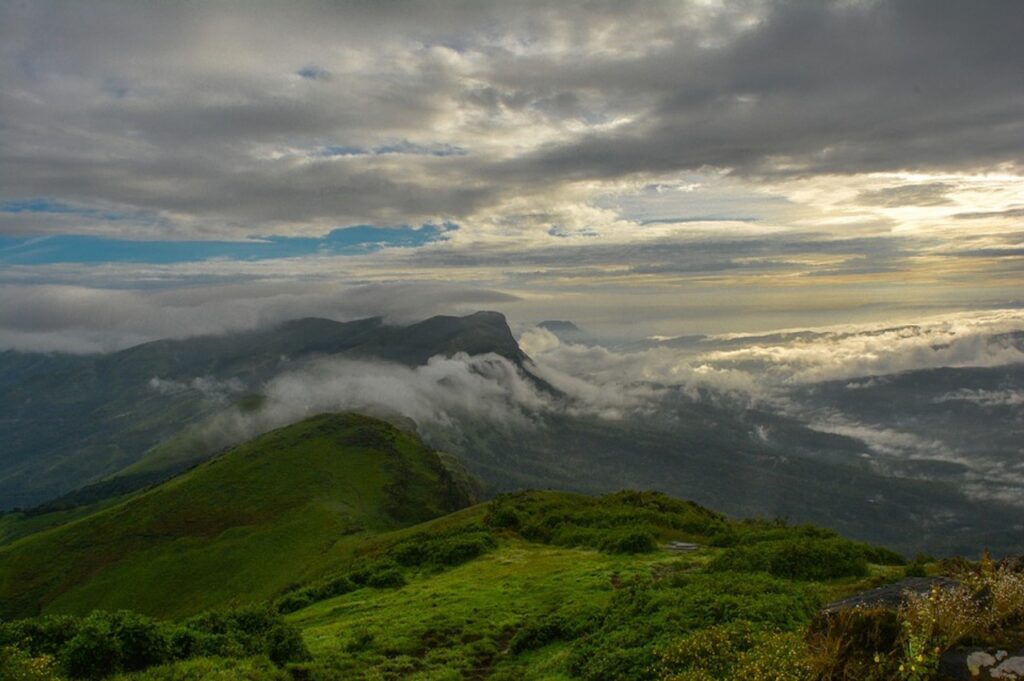
Itinerary For Chopta Tour Package
DAY 0: Delhi to Rishikesh to Sari Village
- Journey Start Time: Depart from Botanical Garden Metro Station at 10:00 PM.
- Begin your overnight journey towards Sari Village via Rishikesh.
- Stop at Devprayag: Witness the confluence of the Bhagirathi and Alaknanda rivers during the journey.
DAY 1: Sari Village to Deoriatal
- Arrival at Sari Village: Check in to your homestay and freshen up.
- Trek to Deoriatal: Start your trek (2 . 5 km, approx. 1.5-2 hours).
- Enjoy Deoriatal: Relax and take in the serene views of the lake.
- Return to Sari Village: Returning to your starting point and enjoy the evening.
DAY 2: Sari Village to Tungnath & Chandrashila
- Breakfast: Enjoy a hearty breakfast at your homestay.
- Drive to Chopta: About 1 hour from Sari Village.
- Trek to Tungnath Temple: 3.5 km trek.
- Summit Chandrashila: An additional 1.5 km from Tungnath.
- Return to Chopta/Sari: After completing your treks, head back for an overnight stay at Chopta camps.
DAY 3: Chopta to Delhi
- Breakfast: Have an early breakfast at your camp in Chopta.
- Early Morning Departure: Leave Chopta early in the morning.
- Visit Dhari Devi Temple: Stop on your way back.
- Return to Delhi: A long drive of approximately 10-12 hours.
Route Overview: Understanding the Chopta Tungnath to Chandrashila Trail
The Chopta Tungnath Trek is a short yet stunning high-altitude trail located in Uttarakhand’s Rudraprayag district. Known for its spiritual significance and panoramic Himalayan views, this trek is one of the most accessible in India. During the monsoon, the route takes on a magical charm—blanketed in mist, enriched with vibrant flora, and offering an almost surreal trekking experience.
The trail begins from Chopta, a picturesque village sitting at around 2,600 meters (8,530 ft). From here, the trek ascends gradually through lush alpine meadows and dense forests of rhododendron and oak. The path is stone-paved for most of the way and leads to Tungnath Temple, the highest Shiva shrine in the world, located at 3,680 meters (12,073 ft). This segment covers approximately 3.5 km and typically takes 1.5 to 2.5 hours to complete.
The monsoon season transforms this leg of the trail. Frequent rainfall makes the stones slippery and introduces patches of fog, reducing visibility. But this also brings out the best of the region’s natural beauty—ferns, moss, and wildflowers line the path, and the entire forest radiates a fresh, rain-soaked vibrance. The Tungnath temple trek during this time feels less like a physical challenge and more like a spiritual walk through the clouds.
From Tungnath, the trail continues another 1.5 km uphill to reach the Chandrashila summit, which stands tall at 4,000 meters (13,123 ft). This portion is steeper and more rugged, with narrow rocky paths and increased exposure to wind and rain. The climb typically takes 45 minutes to an hour, and while the views may sometimes be hidden behind clouds, the serenity and energy of the summit are deeply rewarding.
The total round-trip distance for the Chandrashila summit trek is around 9 to 10 km, with an average trekking time of 5 to 6 hours including breaks. It is strongly recommended to start early in the day during monsoon to avoid afternoon storms and ensure a safe descent before dark.
In summary, while the Chopta Tungnath Trek becomes more demanding in monsoon conditions, it also offers an unmatched blend of solitude, beauty, and spirituality—perfect for trekkers seeking a peaceful escape in the lap of the Himalayas.
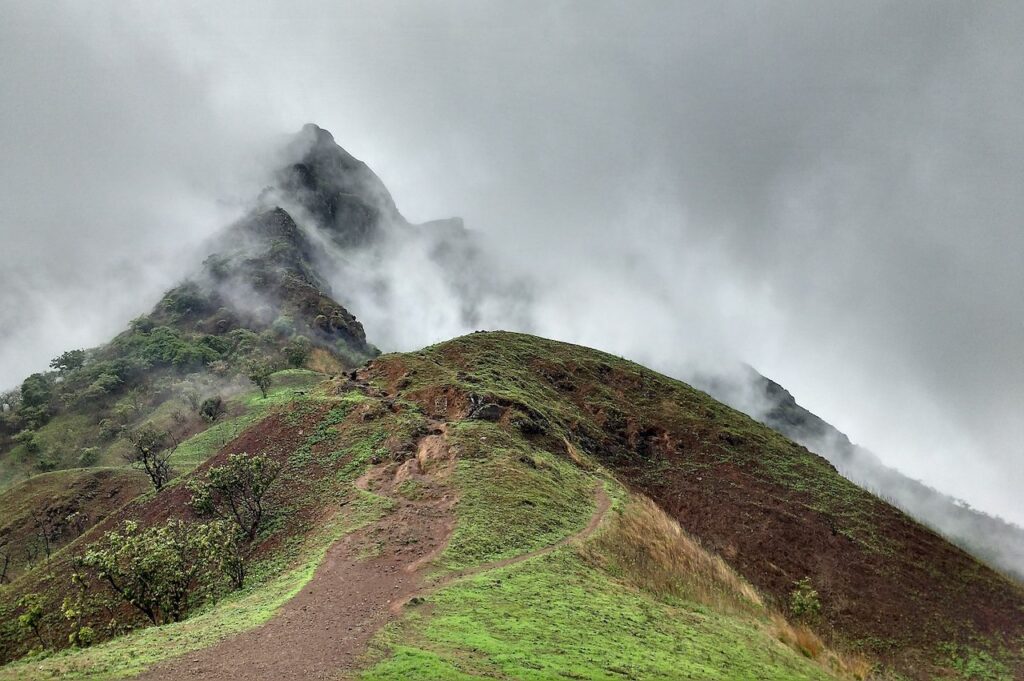
Weather Watch: What to Expect from Chopta’s Monsoon Climate
If you’re planning to explore Chopta in monsoon, be prepared for a dramatic blend of beauty and unpredictability. From mid-June to early September, the entire Chopta valley transforms into a lush green wonderland, nourished by frequent rainfall and wrapped in thick mountain mist. But with this transformation comes a unique set of weather conditions that every trekker should understand—especially if you’re attempting the Chopta Chandrashila trek during this season.
Rain is almost a daily affair in the monsoon months. Mornings may start clear and crisp, but by afternoon, the clouds usually roll in, bringing light to heavy showers. Visibility on the trail can change within minutes, and dense fog often blankets the forest paths and ridgelines, adding both mystique and challenge. This limited visibility requires extra caution while trekking, particularly on steep or uneven sections near Tungnath and Chandrashila.
Temperature-wise, the days remain cool, hovering between 8°C and 18°C, while nights can dip further, especially at higher altitudes. Humidity stays high, and the wind at the Chandrashila summit can make it feel even colder. Waterproof jackets, layered clothing, and proper footwear are essential to stay warm and dry throughout the journey.
The trails, especially the stone paths, become slippery due to moss and rainwater. Trekkers need to watch their step and avoid rushing. Landslides are rare on the Chopta route but can occur on the road while reaching the base, so it’s wise to keep track of local weather updates.
Despite these challenges, the monsoon breathes life into Chopta. The forests are greener, the streams fuller, and the landscape feels alive in a way that no other season can replicate. With proper preparation and respect for the weather, the Chopta Chandrashila trek in monsoon is not only possible—but unforgettable.
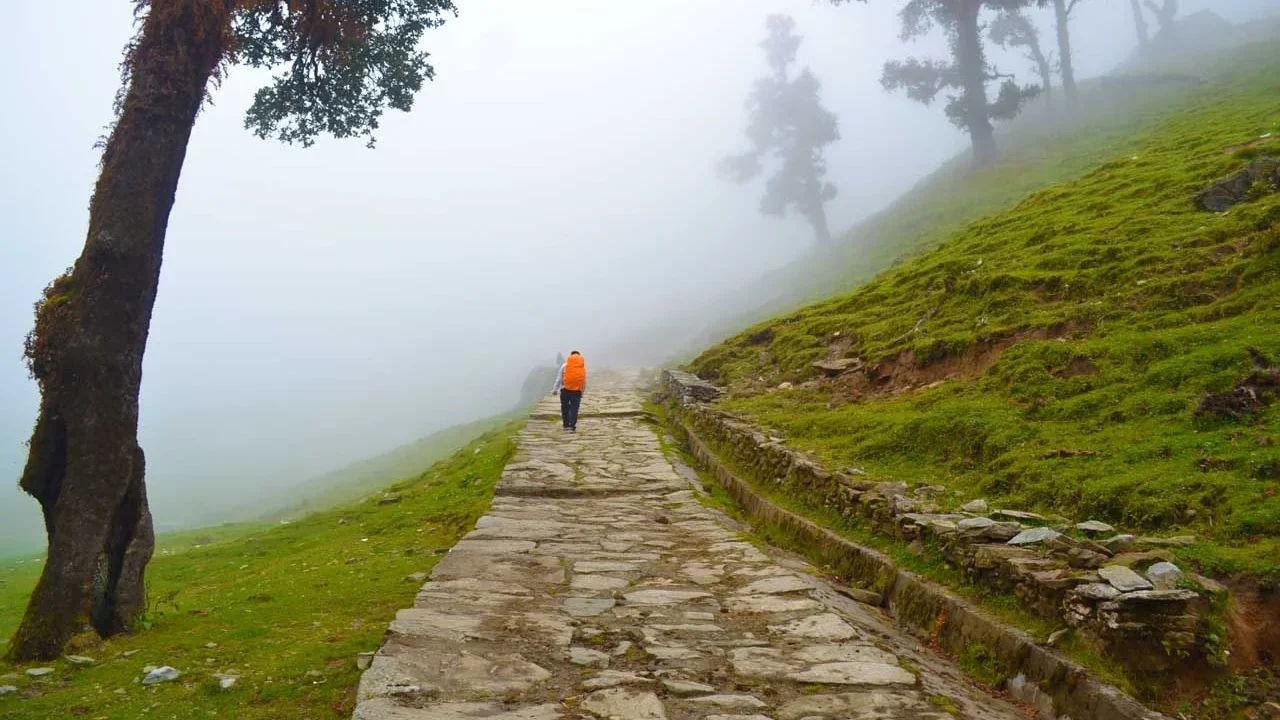
Packing Essentials for a Wet and Wild Chopta Trek
If you’re planning the Chopta Tungnath Trek from Delhi during monsoon, packing smart can make the difference between a memorable adventure and a soaked struggle. Rain in Chopta isn’t just a passing shower—it’s frequent, heavy, and can turn even the best-maintained trails into slippery terrain. Being well-prepared is the first step to staying safe, dry, and energized.
Let’s break down your monsoon trekking essentials:
1. Rain Gear is Non-Negotiable
Carry a high-quality poncho or rain jacket with a hood. Lightweight yet durable rain protection is a must, especially when sudden downpours hit while you are mid-trail. A backpack rain cover is equally important to protect your essentials.
2. Trekking Shoes with Good Grip
For the Chandrashila Trek, ditch the sneakers. Invest in proper waterproof trekking shoes with anti-slip soles and ankle support. Wet rocks and mossy paths are common, especially from Tungnath to the summit.
3. Waterproof Backpack or Liners
Use a rucksack with internal dry bags or waterproof liners. This helps keep clothes, electronics, and food dry in case of rain exposure during long treks or travel from Delhi.
4. Quick-Dry Layers and Extra Socks
Cotton is a no-go. Pack quick-dry clothes, especially thermal inners and lightweight trekking pants. Carry 2–3 extra pairs of socks to avoid blisters and fungal infections after wet trails.
5. Trekking Poles
Not everyone uses them, but in monsoon they can be game-changers. Trekking poles offer stability on steep, muddy paths and reduce knee strain during descents.
6. Cap, Buff, and Headlamp
A cap keeps rain out of your eyes. A buff protects your neck from windchill. A headlamp is essential, especially when daylight fades quickly under cloud cover.
7. First Aid + Anti-Leech Care
Pack basic first aid, antiseptic, and anti-leech socks or Dettol spray. Leeches are common in wet forest trails around Chopta.
8. Personal Essentials
Carry biodegradable wet wipes, tissues, sanitizer, a microfiber towel, and eco-friendly soap. Avoid overpacking—you’ll feel every extra gram on the uphill climb.
For those starting the Chopta Tungnath Trek from Delhi, remember: your journey begins on the road. So pack light, waterproof, and with versatility in mind—especially for the ever-changing Himalayan monsoon mood.
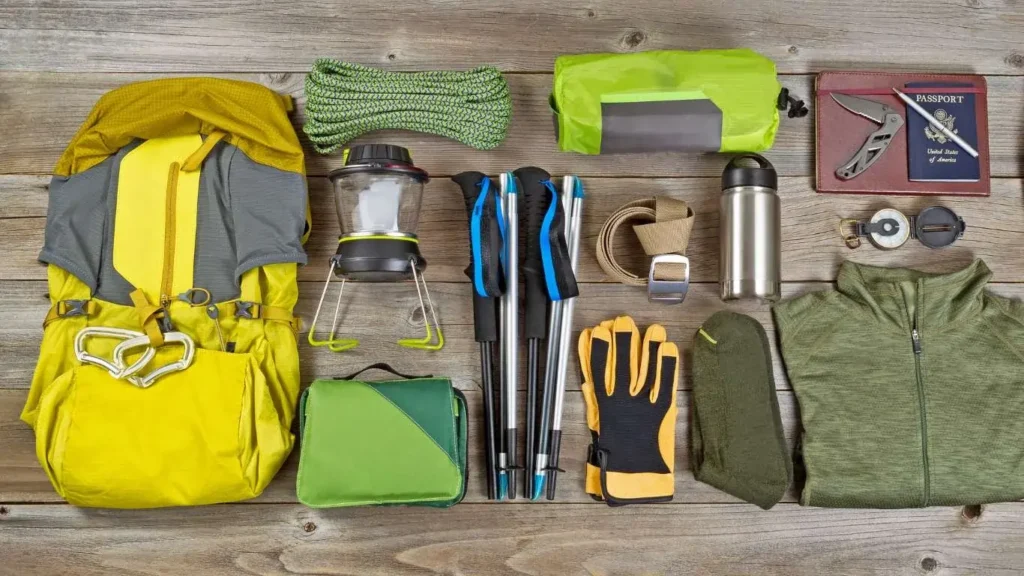
Physical Preparation: Fitness Tips for Monsoon Trekking
The Chandrashila summit trek may be short in distance, but don’t let that fool you—it’s physically demanding, especially during the monsoon. Wet trails, reduced visibility, and steep gradients mean your body needs to be ready for both endurance and balance. If you’re planning the Chopta Chandrashila trek from Delhi, it’s important to start preparing at least 3–4 weeks in advance to fully enjoy the journey.
Build Your Stamina
Begin with cardio workouts like brisk walking, jogging, cycling, or stair climbing. Aim for 30–45 minutes a day, 5 days a week. Endurance is key, especially for trekking at higher altitudes where oxygen levels are lower.
Strengthen Your Legs & Core
Focus on squats, lunges, and calf raises to strengthen the muscles you’ll rely on most. A strong core helps with balance—especially on slippery, uneven trails during monsoon conditions. Add planks and leg raises to your routine.
Improve Flexibility & Stability
Incorporate yoga or stretching sessions to improve joint flexibility. Balance training, like standing on one leg or using a wobble board, can help prevent falls on slick paths.
Practice with a Loaded Backpack
Do short practice hikes or long walks with a 10–12 kg backpack to simulate real conditions. This prepares your body for the added load and increases muscular endurance.
Prevent Altitude Sickness
The Chandrashila summit rises to over 4,000 meters, so acclimatization is crucial. If you’re arriving from Delhi, take your time ascending. Stay hydrated, avoid alcohol, and spend a night in Chopta before trekking up. Carry Diamox if you’re prone to altitude issues—but consult a doctor before use.
With consistent fitness preparation, the Chopta Chandrashila trek from Delhi becomes not just manageable, but enjoyable—even in the rain. Train smart, trek safer.
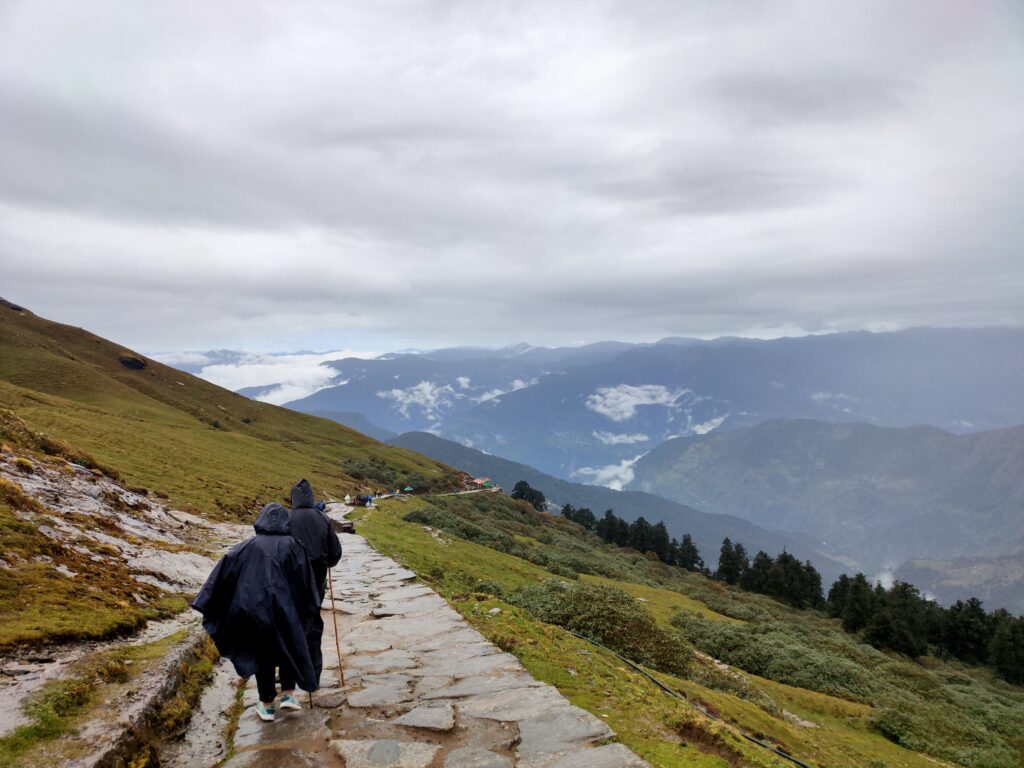
Safety First: Monsoon-Specific Trekking Hazards & How to Avoid Them
The Tungnath temple trek during monsoon offers breathtaking beauty—but it also comes with a unique set of safety concerns that every trekker must be aware of. The rainy season adds an unpredictable layer to the Himalayan terrain, and understanding these risks is essential for a safe and enjoyable journey.
Common Hazards During Monsoon Treks
1. Slippery Trails:
The stone-paved paths leading to Tungnath and Chandrashila become slippery due to moss, rainwater, and loose mud. Falls are common among first-timers.
2. Low Visibility:
Thick fog and moving clouds often reduce visibility to just a few meters. This makes it easy to stray from the trail—especially near the ridgelines leading to Chandrashila summit.
3. Landslides:
While the Tungnath temple trek itself is relatively safe, roads leading to Chopta (especially via Ukhimath or Gopeshwar) can experience occasional landslides. Road blockages may delay your itinerary.
4. Leeches and Insects:
In damp forest sections, leeches are commonly found. Though not dangerous, they can cause discomfort if not managed properly.
5. Hypothermia Risk:
Cold rain combined with wind and soaked clothing can lead to hypothermia, especially at higher altitudes.
Safety Tips for Trekkers
• Choose a Monsoon-Ready Chopta Tour Package:
A well-organized Chopta tour package during monsoon should include waterproof tents, trained guides, emergency support, and proper meal arrangements. Avoid going solo.
• Avoid Trekking in the Dark:
Always begin your trek early and aim to return before late afternoon. Visibility drops sharply post 4 PM during monsoon.
• Hire a Local Guide:
Locals know alternative paths, weather behavior, and how to navigate in fog. Their presence can be lifesaving in tricky sections.
• Carry Anti-Leech Protection:
Wear full-length trekking socks, use Dettol spray on shoes and legs, and avoid sitting on the ground in damp areas.
• Dress in Layers & Carry Dry Spares:
Wear moisture-wicking base layers, and always carry a dry change of clothes. This helps prevent both cold exposure and fungal infections.
• Stay Updated on Weather Alerts:
Before you start the journey, check the IMD (India Meteorological Department) website for updates on heavy rain or road advisories.
Monsoon trekking demands mindfulness, but with the right precautions and a trusted Chopta tour package, the Tungnath temple trek becomes a safe and deeply rewarding adventure—even when the clouds roll in.
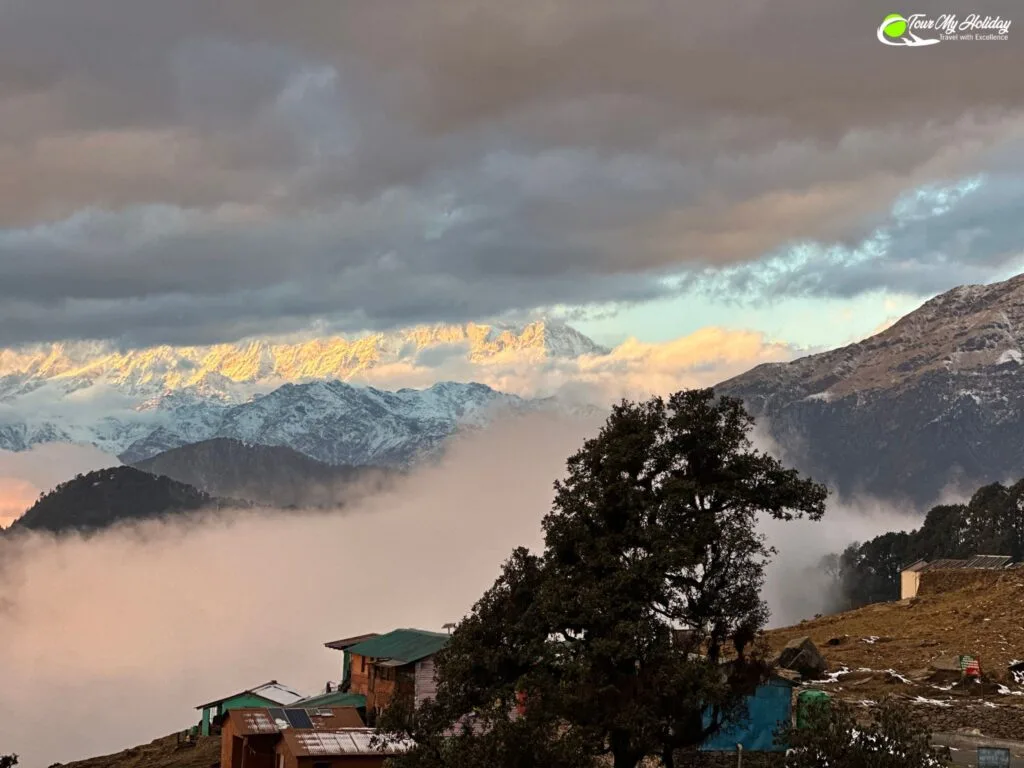
Choosing the Right Package: What to Look for in a Chopta Tour Package in Monsoon
Planning a Chopta Chandrashila trek during the monsoon is thrilling, but it demands the right tour package to ensure comfort and safety. The rains can make trails slippery and the weather unpredictable, so choosing a dependable Chopta tour package from Delhi becomes even more important. These packages often include guided support, proper accommodations, and transportation—making your monsoon adventure more enjoyable and stress-free.
1. Check for Weather-Ready Camping Arrangements
Not all camps are built for the monsoon. Ensure your Chopta tour package includes rain-proof tents, proper flooring, and waterproof sleeping gear. Poor shelter can ruin the experience and even pose health risks in cold, damp conditions.
2. Prioritize Safe & Comfortable Transportation
Monsoon roads in Uttarakhand can be tricky. Opt for packages that offer Delhi to Chopta transport in well-maintained, AC tempo travellers or SUVs with experienced mountain drivers. Look for providers who factor in buffer time for possible delays due to landslides or traffic.
3. Quality Food & Hygienic Facilities
Treks during the rainy season demand more energy. Choose Chopta tour packages that offer nutritious, hot meals and maintain hygiene even in remote basecamps. Bonus points if they provide herbal teas, soups, and local dishes that are light yet energizing.
4. Medical Support & First Aid
Accidents, leech bites, or altitude-related issues can occur. A good Chopta tour package should include a trained guide with basic first-aid knowledge, and carry essentials like antiseptics, bandages, painkillers, and ORS.
5. Experienced Trek Leaders
Your guide should know the Chopta Chandrashila trek well—especially alternative routes, emergency shelters, and weather patterns. Always go with companies that employ certified, local guides who are used to trekking in monsoon conditions.
6. Transparent Inclusions & Real Reviews
Avoid hidden costs. The best Chopta tour packages clearly list what’s included—meals, permits, stay, transport. Look for recent monsoon travel reviews and real user photos before booking.
Whether you’re planning the Chopta Chandrashila trek from Delhi or a shorter trip, a well-thought-out package is key to enjoying the lush green landscapes and mystical foggy trails of Chopta—safely and comfortably.
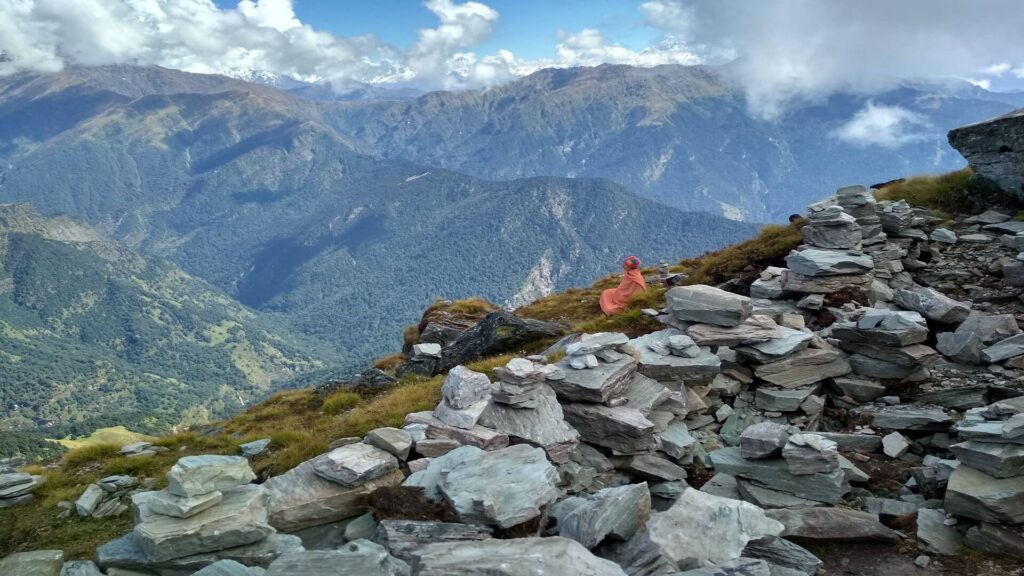
Temple Trails in the Rain: Visiting Tungnath and Omkareshwar in Monsoon
The Tungnath temple trek is a spiritual journey like no other—and when done during the monsoon, it transforms into a soulful experience amid clouds, mist, and emerald green hills. While many travelers shy away from the rains, monsoon offers a unique opportunity to explore these sacred Himalayan sites in serenity and solitude.
Why Visit Temples in Monsoon?
During peak seasons, Tungnath and nearby pilgrimage sites often witness long queues and bustling crowds. But in the rains, the paths are quieter, the ambiance meditative, and the landscape more alive. The Tungnath Chandrashila Trek from Delhi, when taken during this time, offers cooler temperatures and a deeply calming atmosphere—a rare blend of spiritual peace and natural beauty.
Tungnath: The World’s Highest Shiva Temple
Perched at 3,680 meters, Tungnath is one of the Panch Kedar temples. The short but steep Tungnath temple trek from Chopta (approx. 3.5 km) takes you through misty forests, moss-covered rocks, and blooming wildflowers. Carry a poncho, wear good trekking shoes, and start early to avoid heavy afternoon showers.
Omkareshwar Temple, Ukhimath: The Winter Home of Kedarnath
On your way to or from Chopta, stop at Omkareshwar Temple in Ukhimath. This ancient temple becomes the winter seat of Lord Kedarnath and Madhyamaheshwar when snow blocks access to higher altitudes. During monsoon, the temple remains easily accessible by road and offers a peaceful spiritual detour without any major trek involved.
Whether you’re a pilgrim or a trekker, combining spiritual exploration with the Tungnath Chandrashila Trek from Delhi in monsoon adds a new dimension to your journey—offering both peace and perspective in the lap of nature.
Food & Energy on the Trail: What to Eat Before and During the Trek
The Chopta Tungnath and Chandrashila Trek are scenic yet demanding, making nutrition a vital part of the journey. Whether you’re a seasoned trekker or a first-timer, smart eating choices will keep your energy up and digestion smooth—especially in high-altitude wet conditions.
Pre-Trek Fuel
Before hitting the trail, consume a balanced meal rich in complex carbs and lean protein—think oatmeal, boiled eggs, bananas, and a handful of nuts. Avoid dairy-heavy or oily foods that may upset your stomach during the ascent.
On-Trail Energy Boosters
Pack light yet nutrient-dense snacks like:
- Dry fruits (dates, raisins, almonds) for quick sugar and stamina
- Peanut butter sachets or protein bars for sustained energy
- Dark chocolate—a treat that energizes without overloading your system
- Electrolyte sachets or glucose tablets to replenish minerals lost in sweat
Locally available snacks like maggi, paratha, and tea are commonly served at dhabas along the Chopta route but may vary based on weather and footfall.
Hydration & Digestion Tips
- Sip small amounts of water regularly—carry a thermal bottle to keep it lukewarm.
- Avoid ice-cold drinks in misty or rainy conditions, as they can hinder digestion.
- Herbal teas like ginger or tulsi are great for keeping you warm and settled.
What Packages Usually Provide
Most Chopta Tungnath trek packages include simple vegetarian meals—dal, rice, chapati, and sabzi—plus evening tea and light snacks. Breakfast is often hearty (poha, bread, or paratha) to fuel the day’s hike.
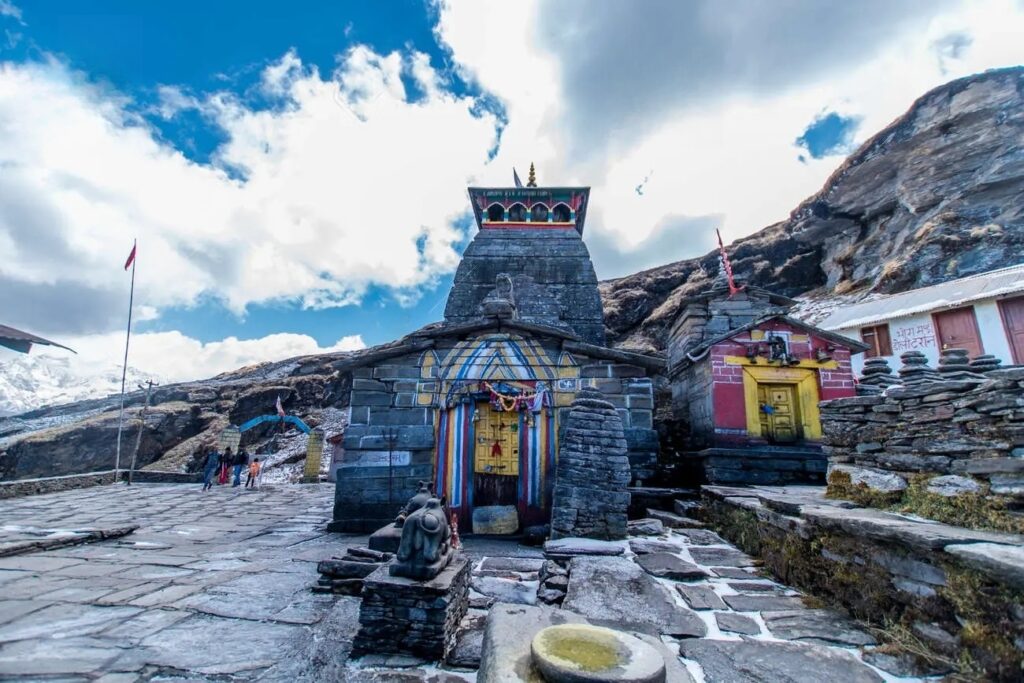
Final Thoughts: Why the Chopta Chandrashila Trek Shines in Monsoon
Monsoon isn’t just a season—it’s a mood. For trekkers seeking a blend of serenity, spirituality, and lush landscapes, the Chopta Chandrashila trek from Delhi during the rains offers a magical experience that summer just can’t replicate.
Why Monsoon is a Hidden Gem
- Green Paradise: Chopta transforms into a misty meadow wonderland, with pine forests and wildflowers lining the trail.
- Cool & Refreshing Climate: No harsh sun—just pleasant drizzle and rejuvenating mountain air.
- Mystical Vibes: Clouds dancing around Tungnath Temple and Chandrashila summit add an ethereal charm.
- Peaceful Trails: Monsoon is less crowded, perfect for trekkers craving solitude and connection with nature.
- Budget-Friendly: Tour packages are often more affordable in off-season, plus personalized guidance from local operators.
What to Know
- Trails may be slippery—carry trekking poles and wear waterproof shoes
- Views from Chandrashila may occasionally be foggy, but the atmosphere is pure magic
- Sudden showers are common, so pack rain gear and keep flexible plans
Best Time During Monsoon
Late July to early September is ideal. Avoid peak downpours and check local forecasts. Routes from Delhi via Rishikesh or Ukhimath provide access and allow early acclimatization.
Personal Recommendation
If you crave a trek that’s spiritually uplifting and visually surreal, Chopta Tungnath in monsoon is a bold and beautiful choice. Book through trusted trekking groups for safety, support, and curated itineraries—they’ll help you experience the mountains in their most poetic form.Get tips for Chopta monsoon trekking.
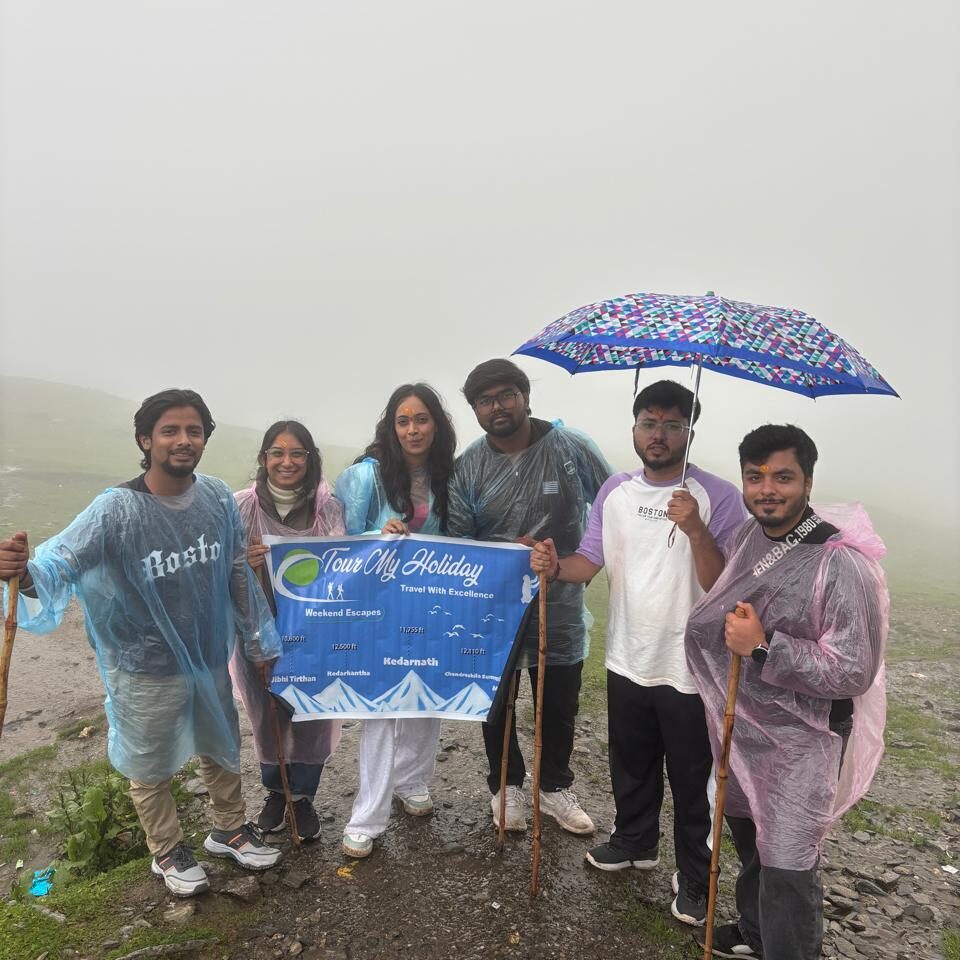
Frequently Asked Questions (FAQs)
- Where is the Chopta Chandrashila trek located?
The trek is in the Garhwal region of Uttarakhand, starting from Chopta and leading to Tungnath Temple and Chandrashila summit. - What is the total distance of the Chopta Chandrashila trek?
The trek is around 9–10 km round trip from Chopta to Chandrashila via Tungnath. - How difficult is the Chopta Chandrashila trek?
It’s considered an easy to moderate trek, suitable for beginners with basic fitness. - What is the altitude of Chandrashila summit?
Chandrashila stands at an altitude of about 4,000 meters (13,000 feet). - What is the best time to do the Chopta Chandrashila trek?
March to May and September to November are the best months for clear views and good weather. - Can the trek be done in winter?
Yes, but winter treks (December–February) are tougher due to snow; proper gear is essential. - Is a guide required for the trek?
It’s not mandatory, but hiring a local guide is helpful for first-time trekkers. - How do I reach Chopta from Delhi?
You can reach Chopta via Rishikesh or Haridwar by bus/train, followed by a cab or shared jeep. - Are there tour packages available from Delhi?
Yes, many travel operators offer Chopta tour packages from Delhi, including transport, stay, and trek. - Is camping allowed in Chopta?
Yes, there are many budget-friendly campsites and eco-resorts in and around Chopta. - How cold does it get at Chandrashila?
Temperatures at the summit can drop to -5°C or lower during early mornings or winters. - What should I pack for the trek?
Warm clothes, trekking shoes, water bottle, energy snacks, raincoat, torch, and basic medicines. - Can I see snow during the trek?
Yes, from December to February, the trail and Tungnath Temple are usually covered in snow. - Is it safe to travel solo on this trek?
Yes, it’s generally safe, especially in peak season, but always inform someone about your plans. - Is the trek suitable for kids or elderly people?
With caution and regular breaks, it can be done by kids above 10 and fit elderly individuals. - Are there ATMs or mobile networks in Chopta?
ATMs are limited; carry cash. Mobile signals (Airtel, Jio) are patchy or unavailable in some areas. - Is there food available on the trek?
Yes, local dhabas offer simple meals like Maggi, parathas, dal-rice, and tea along the route. - Can I do both Deoria Tal and Chandrashila in one trip?
Yes, many travelers combine both in a 2–3 day itinerary. - Is there any spiritual significance to this trek?
Yes, Tungnath Temple is part of the Panch Kedar and is the highest Shiva temple in the world. - Do I need a permit for the trek?
No major permits are required, but a small forest entry fee may be applicable at checkpoints.